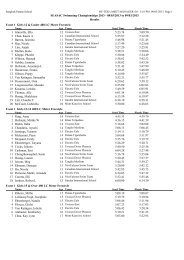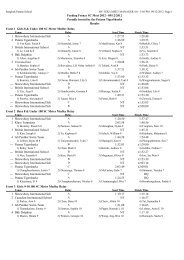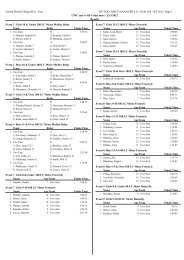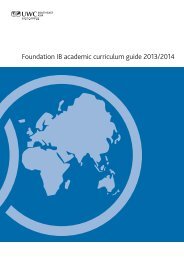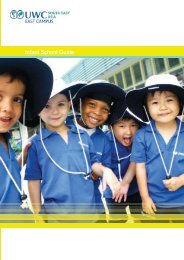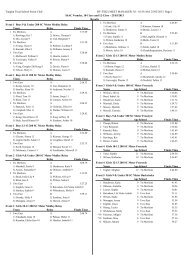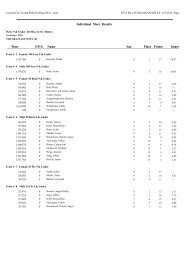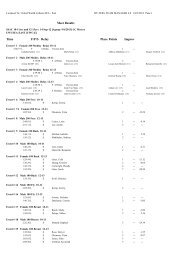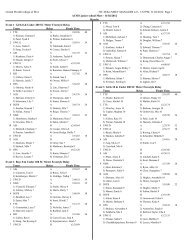Scholars enhance UWC life - United World College of South East Asia
Scholars enhance UWC life - United World College of South East Asia
Scholars enhance UWC life - United World College of South East Asia
You also want an ePaper? Increase the reach of your titles
YUMPU automatically turns print PDFs into web optimized ePapers that Google loves.
Dunia, April 2010<br />
38<br />
Cheshire Homes Visit<br />
We recently had the pleasure <strong>of</strong> visiting a home for severely disabled adults called<br />
‘Cheshire Home’. One <strong>of</strong> our goals was to gain insight into Upper School student<br />
involvement in local service and to find out about the challenges <strong>of</strong> communicating with<br />
people who have disabilities. Take John (pictured), a resident at the home, who understands<br />
English, but is unable to speak; he is able to make his wishes understood through<br />
a series <strong>of</strong> facial expressions and nods. Through trial and error, we eventually managed<br />
to help him water his beloved plants in the back garden! John was encouraging and constantly<br />
had a smile on his face, making helping and talking to him all the more rewarding.<br />
Here are the thoughts <strong>of</strong> some <strong>of</strong> the Grade 9 students we spoke to:<br />
“It’s a great experience working with these people because it gives me such gratification<br />
to know that I am making a difference” and “In my previous schools we never had<br />
the opportunity to work with disabled people so I found it interesting and felt a sense <strong>of</strong><br />
achievement after seeing them smile”<br />
Our visit to Cheshire Home is one that we will treasure forever because to walk into a<br />
room and have so many faces smiling at you is truly a once in a <strong>life</strong>time experience.<br />
Talking to all the students that regularly visit the home showed us how much the students<br />
enjoy it because not only does it make the people happy but it makes the students<br />
happy because even doing some small act kindness like watering plants makes them<br />
feel like they have made a difference. This truly was a pleasurable and heartwarming<br />
experience and we hope that we can go back to Cheshire Home again.<br />
Danielle Iserlis (10JLC), Ambika Chanrai (10DWi) and Yuka Shimizu (10JLC) - Service Initiative<br />
Awareness Group<br />
Dutch trip to Melaka<br />
The time to leave to Melaka had finally<br />
come for us, the Dutch students <strong>of</strong> Grade<br />
9 and 10. There were nine <strong>of</strong> us - seven<br />
students, our teacher and a parent on a<br />
weekend to study the Dutch cultural heritage<br />
in a town occupied by the Dutch from<br />
1641 to 1825.<br />
Welcomed by a big billboard “Selamat<br />
datang ke Melaka”, we drove into the<br />
town and our attention was immediately<br />
drawn to the brilliant red buildings, many<br />
<strong>of</strong> them built by the Dutch, including the<br />
Stadthuys and Christ Church.<br />
After checking into our hotel, we had<br />
a very satisfying meal, then roamed<br />
through Melaka’s night market. The next<br />
day, we went on the ‘Dutch trail’, a trail<br />
leading to old sites built or influenced by<br />
the Dutch. Our first stop was Saint Paul’s<br />
church built by the Portuguese but later<br />
turned into a Protestant church, where we<br />
located and analyzed gravestones with<br />
Dutch inscriptions. We continued our walk<br />
to the Porta de Santiago, originally built<br />
in S-shape by the Portuguese to avoid<br />
direct cannon fire. After the Dutch conquered<br />
Melaka from the Portuguese in<br />
1641, they added the year ‘1660’ on the<br />
Photo by Elly Kreijkes<br />
gate as well as the symbol <strong>of</strong> the VOC,<br />
the ‘Vereenigde Oost-Indische Compagnie<br />
(<strong>United</strong> <strong>East</strong> Indies Company).<br />
As we walked on, we passed the Dutch<br />
cemetery for high-ranking VOC <strong>of</strong>ficers<br />
and their families, and we also found<br />
British gravestones from the 19 th century.<br />
There were about 30 graves in total, and<br />
it was our “job” to find a particular one <strong>of</strong><br />
a Dutch woman. Fortunately we did have<br />
a map. Then we visited the most interesting<br />
site <strong>of</strong> all, the Stadthuys, which was<br />
once the residence <strong>of</strong> the Dutch gover-<br />
nor, and has now been transformed into a<br />
museum. Inside we could see how people<br />
lived a couple <strong>of</strong> centuries ago, and how<br />
the drainage system was built from the<br />
house to the Melaka River. Our last stop<br />
before lunch was Christ Church, built by<br />
the Dutch in 1741, to commemorate 100<br />
years <strong>of</strong> their presence in Melaka.<br />
After a short rest, we visited 8 Heeren<br />
Street, a house built by the Dutch and recently<br />
restored with the help <strong>of</strong> the Dutch<br />
Government. Our tour guide mentioned<br />
that the Dutch were masters at building<br />
houses that were strong and durable, and<br />
they knew how to vary the height <strong>of</strong> the<br />
houses to combat fires that could easily<br />
destroy whole streets.<br />
The Melaka trip was fun and interesting,<br />
and I believe that Dutch students<br />
will enjoy this trip in the future, as we<br />
learn about our country’s influence in<br />
<strong>Asia</strong> and how layers <strong>of</strong> different cultures,<br />
Portuguese, Dutch, British, Chinese and<br />
Malaysian, are intertwined.<br />
Michiel Vriens




